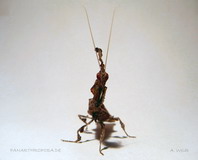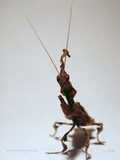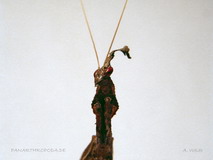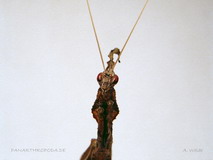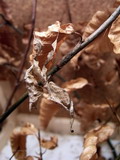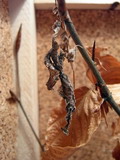- Acanthopidae
- Amorphoscelidae
- Empusidae
- Eremiaphilidae
- Hymenopodidae
- Iridopterygidae
- Liturgusidae
- Mantidae
- Metallyticidae
- Sibyllidae
- Tarachodidae
- Thespidae
- Toxoderidae

Phyllocrania paradoxa (Burmeister, 1838)
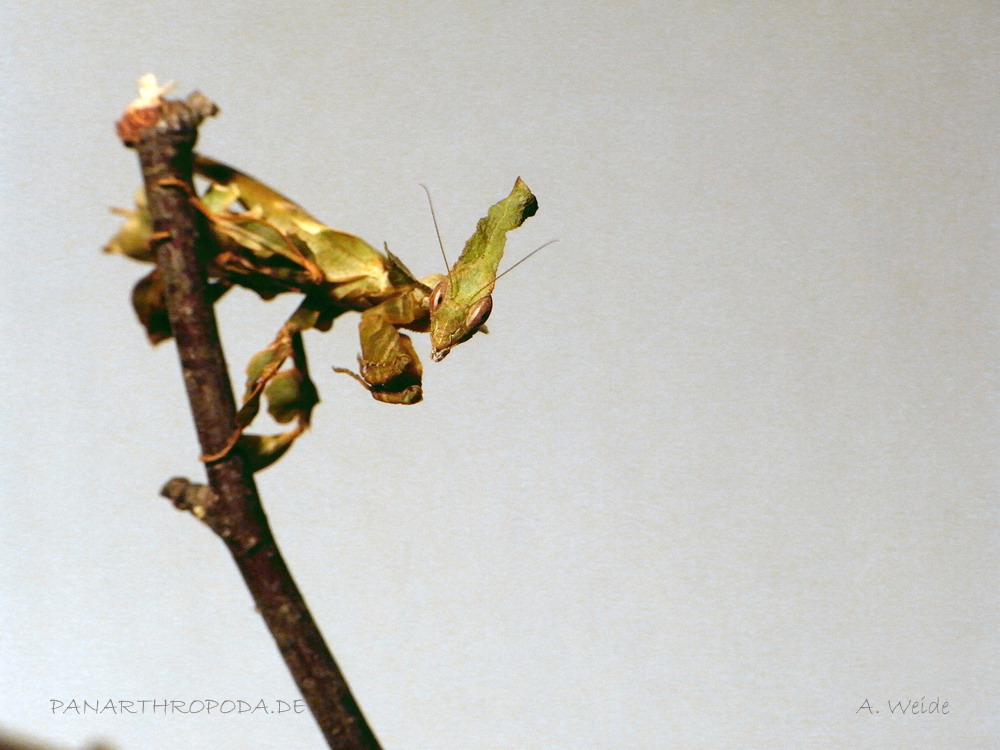
Adult female
Origin and occurrence
Phyllocrania paradoxa is a species of mantid with a very large area of distribution. It inhabits the tropic and subtropic regions of Africa, it has been found in Angola, Cameroon, Congo, Ethiopia, Ivory Coast, Ghana, Guinea, Kenia, Madagascar, Mozambique, Namibia, Somalia, South Afrika, Sudan, Tanzania, Togo, Uganda and Zimbabwe. Therefore this species is distributed almost everywhere in Africa south of the Sahara Desert.
Appearance and sexual dimorphism

Adultes M├żnnchen
Phyllocrania paradoxa is a mid-sized species reaching up to 5 cm in bodylength in both sexes (without wings). The variability of color is characteristic for this species, reaching from almost black to sandy yellow and green. Nontheless the animals are not plain-colored, but show a faint pattern of stipes and dots, which is only visible to the closer look. The habitus with its long, jagged vertex elongation and lobe-like appendages on the abdomen and the walking legs is based on a leaf. The veins of the wings, which are mostly transparent, help with this imitation.
Phyllocrania paradoxa is easily sexed. First the males have 8 abdominal sements, the females have only 6. A further distinguishing mark is the "crown" (vertex elongation). In females, it is rather wide, not jagged and shows a slight median bend to the left. The male's crown is longer, more slender and jagged. In addition, the male's wings reach over the abdomen, which is not the case in females. The antannea of the male are longer then the female's, too. The sexual dimorphism of the crown can be already used in larvae.
Behavior
Phyllocrania paradoxa is a very calm and compliant species. The animals are, in contrast to other mantids, rather active, whereas the adults are more faithful to their location than juveniles. The excellent flying skills of the males are to be pointed out, I have never seen any attemps to fly in females.
Their way of hunting fits their behavior. They seldom move towards the prey items, but wait for it to come close enough. The last centimeters can be stretched be moving, of course. Phyllocrania paradoxa is capable of catching flying prey mid-flight, due to its astonishingly short reaction time and perfect catching reflexes.
As mentioned before, the juveniles are more active than the adults. Their swaying way of moving is characteristic and reminds of a leaf in the wind. This behavior can be seen in adults, too.
Keeping conditions
Due to its low potential for aggression, this species can be kept in groups well. The males should be seperated however, since the males often fall victim to the stronger and as adults very hungry females. A container measuring 30x30x40 cm can house a group of about 5 to 10 specimen. Temperatures during day should reach about 35 ┬░C, whereas temperatures of about 25 ┬░C near the ground are beneficial. This way the animals can choose their best spot for themselves. Night temperatures of about 20 ┬░C are fine. Adults cope with longer dry periods very well, I spray no more than once per week.
Paper towels can be used as substrat, or matching the habitat a mixture of sand and earth. The terrarium should contain many twigs for climbing on, but keep in mind the space needed for molting. Twigs with withered leafs are a good fit for the habitus of Phyllocrania paradoxa.
The animals can be fed with insects up to their own size. Flying insects like flies, bees and moths are accepted as well as crickets or grasshoppers. My specimen always got along with feeding crickets very well.
Mating and raising the young
The breeding and raising of Phyllocrania paradoxa is no big challenge. The young larvae should be kept a little bit colder, at about 25 - 30 ┬░C, and at a higher humidity. Older larvae cope with higher temperatures and lower humidity, too. It seems best to match the keeping conditions of the larvae to those of the adults step by step. The animals can reach maturity in about 4 months if kept well.
Breeding this species is easy, too. About 3 weeks after the last molt the females are ready for mating and start to spray pheromones. This shows as rythmic pumping-movements of the abdomen. Now, the male can be introduced (it is sexually mature one week after the final molt). After a successful mating the females will lay up to 8 oothecae, mostly on twigs, seldom on even surfaces. To make sure that all are fertilized the female should be mated once again after the laying the first oothecae.
The oothecae should be yielded at about 30 ┬░C and a constantly high humidity. 4 to 6 weeks later 20 to 30 young will hatch. In the first state the young are totally black and feed on Drosophila hydei. One to two molts later the typical colorations of Phyllocrania paradoxa start to show. These can change several times during the developement of the larvae, however. I can not confirm the common notion, that the animals will get green when raised at high humidity and with green accommodations. In my case many specimen kept dry and only with brown accomodations became green. This morph appears in males, too (Ehrmann, 2002), however, most of mine became brown.
Diagnosis
Phyllocrania paradoxa is a good fit for beginners, because it is easily kept and not aggressive. The need or space is low, too, since this species can be kept in groups without much problem.
A. Weide


